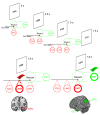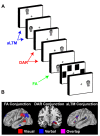Trisecting representational states in short-term memory
- PMID: 24324424
- PMCID: PMC3840432
- DOI: 10.3389/fnhum.2013.00796
Trisecting representational states in short-term memory
Abstract
The ability to hold information briefly in mind in the absence of external stimulation forms the core of much of higher-order cognition. This ability is referred to as short-term memory (STM). However, single-term labels such as this belie the complexity of the underlying construct. Here, we review evidence that STM is an amalgamation of three qualitatively distinct states. We argue that these distinct states emerge from the combination of frontal selection mechanisms (often considered the domain of attention and cognitive control), medial temporal binding mechanisms (often considered the domain of long-term memory, LTM), and synaptic plasticity. These various contributions lead to a single representation amenable to elaborated processing (focus of attention), a limited set of active representations among which attention can be flexibly switched (direct-access region), and passive representations whose residual traces facilitate re-activation (activated LTM). We suggest that selection and binding mechanisms are typically engaged simultaneously, providing multiple forms and routes of short-term maintenance. We propose that such a framework can resolve discrepancies among recent studies that have attempted to understand the relationship between attention and STM on the one hand, and between LTM and STM on the other. We anticipate that recent advances in neuroimaging and neurophysiology will elucidate the mechanisms underlying shifts and transformations among these representational states, providing a window into the dynamic processes of higher-order cognition.
Keywords: attention; long-term memory; medial temporal lobe; prefrontal cortex; working memory.
Figures




References
Publication types
Grants and funding
LinkOut - more resources
Full Text Sources
Other Literature Sources

